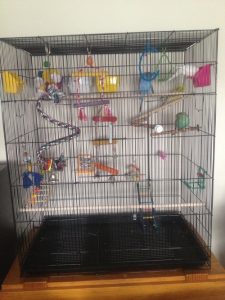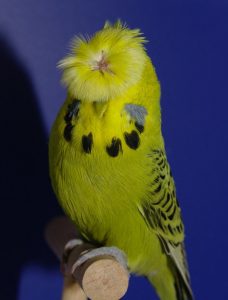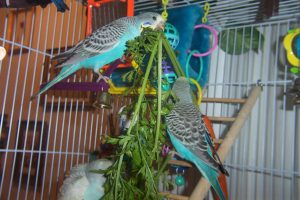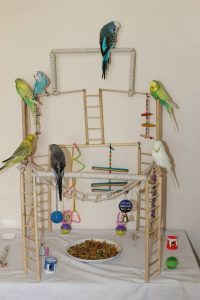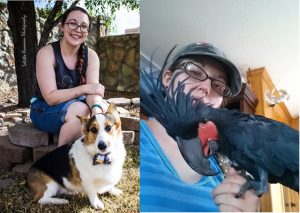Re-Cap of Part I
Budgerigars, more commonly known as parakeets or budgies, are very popular and a highly recommended beginner pet bird. Due to their small size, easy care, and vibrant personalities, these birds have become well known in many pet stores. As a very small parrot, budgies have a noticeable intelligence as well as being interesting and easy to train. We went over the origins, how to pick your new budgie, the colors available, health, age, and gender in Part I of this series. In Part II we will discuss essentials, diet, cleaning, and toys! Read Part I before reading this segment to gain the most knowledge possible!
Essentials
Budgies need an area that can be described as “theirs.” A horizontally barred cage with different levels of perches is the number one item you will absolutely need. Investing early in a large, decent cage will definitely be worth it in the long run. The cage and perches will most likely be the most expensive items in the beginning, but it is better to purchase one nice cage early on as a bird owner instead of continually purchasing lower quality cages every few years.
The appropriate cage size for a budgie should be considered to be about 24 inches long by 24 inches wide and a minimum of 24 inches high. This size is adequate for two budgies and can be expanded if more birds will be sharing the space. The most important feature in the cage are the horizontal bars. The maximum space between bars that is safe for budgies is 1/2 an inch apart. Any more space than this and the birds would possibly be able to escape or manage to become stuck between the bars which will definitely cause great trauma, stress, and harm to the bird.
Budgies often love to climb up the sides of the cage, and they would love plenty of smooth or natural perches (not made of sand paper or similar coarse textures which may injure their feet) to climb and explore vertically. Because of the exploratory curiosity of these birds, it is best to avoid cages with a lot of decoration and architectural variation because a little bird toe may easily become caught in places one does not expect. Keep it basic and the birds will become the happiest and most beautiful feature in their cage!
Price ranges for the birds themselves run from $15 to $25 per bird from pet stores, and breeders may establish various prices depending on each bird’s unique characteristics. There are some varieties of budgie such as the crested budgerigars, a popular variant breed that may change the actual price of the bird. Crested budgies are often seen at bird shows along with other breeds.
Diet
The best way to keep your bird healthy is to feed them a diet similar to what they would find in the wild and to mimic some of their natural foraging habits. Components to a Budgerigar diet include seed, fresh fruit, fresh veggies, and occasional treats. The seed can be a store bought pre-made blend made specifically for budgies or small parrots. It is best to look for blends that contain canary seed (this is the actual name of a seed, not specifically related to the bird of the same name), millet, and just a small amount of oats. It is very important to keep an eye on the fat content of your bird’s overall diet. Foods such as oats and sunflower seeds have a certain percentile of fat which, depending on the birds exercise levels, can lead to pudgy budgie buddies. These fattier foods can be given as occasional treats.
There are also a wide variety of fresh food items that are safe and fun to offer to your budgies as a major portion of their diets, or as treats. Some favorites that I personally find fascinating are broccoli, zucchini, fennel seed, hard-boiled eggs, apples, and even lemons. Budgies can be a little hesitant when trying new foods, but when offered consistently and mixed with some known foods, your bird will have a variety of treats to enjoy. When offering food, don’t always place it in a food bowl. Provide food in a way to promote activity and encourage mental exercise. A good example is to place spray millet in the top or side of the cage to promote acrobatic acts of the bird while they stretch, hang, and cling in order to reach and enjoy the food.
Cleaning
As with most pets, aspects of maintenance need to become routine. Some items, like food dishes and water bowls, need to be cleaned and sanitized daily while others, such as the entire cage and perches may only need monthly or weekly cleaning depending on how many birds share the space. Items that should be cleaned daily include dishes, cage liners, bird baths, and areas surrounding the cage (birds like to be messy and throw seed hulls and other debris outside the cage area). When doing these daily cleaning tasks, it is best to look to see if there are any changes in the bird’s habits such as normal waste, amount of food eaten, and the condition and cleanliness of toys. Things that need to be cleaned weekly or monthly include the cage and the perches themselves. Allow a few hours for this task because you will need to disassemble the cage and remove all toys and accessories in order to do a thorough scrubbing of bars and perches with animal friendly disinfectants that are still strong enough to prevent bacteria.
During that intensive cleaning process, it is a good time to allow your budgie to have its daily out-of-cage exercise. Budgies are nomadic birds and need time outside of their confined space. Whether you choose to let your budgie’s wings stay long or would prefer to have their wings clipped (consult and discuss with your vet about wing clipping procedures), budgies will need time outside to explore and play in a safe environment where you can easily supervise them. Constructing a fun enrichment area (which can include a jungle gym with lots of toys that are easy to interchange) provides a stimulating out-of-cage experience for your bird.
Toys
When picking out toys for your budgie, a variety will keep your bird physically and mentally active. Changing the toys around often also prevents birds from becoming bored. Factors to consider when picking out toys are color, texture, safe material, interactivity, and how exciting they are. As you get to know your bird(s), you will find out what types of toys are their favorites. Warning: some toys may cause noise and may want to be limited to daytime play only. For example, your budgie may really love ringing and jingling bells. Noises appropriate during the day may be disturbing to the rest of the household at night! It is also possible to incorporate treats with their toys, like a challenge or a test, to stimulate foraging habits and exercise.
Summary
Budgerigars are amazing and fun little avian buddies filled with just as much personality as the colors of their feathers indicate. Very intelligent and fun to be with, budgies are excellent little parrots to have as a companion either as a first-time bird owner or a veteran bird lover.
Ashley Gurnea, our Avian Editor, is a certified bird feeding specialist at Wild Birds Unlimited. A graduate from New Mexico State University, Ashley earned her bachelor degree in the field of Animal Science. She completed an internship at an exotic animal park, working with animals ranging from camels to porcupines and a variety of birds such as parrots and cockatoos. This love and curiosity of aviary has led her to her current position at Wild Birds Unlimited in Las Cruces where she remains up to date with local wild feeder birds. Growing up in a home where animals have always been present, Ashley is now a self-proclaimed “Corgi Countess” due to her love and adoration for her tricolor Pembroke welsh corgi, Colin. Bring up anything corgi or bird related in a conversation and Ashley will be happy to share her many photos. Feel free to ask her about pet birds, and visit Wild Birds Unlimited for questions on wild birds! Ashley can be reached at ashleygurnea@gmail.com.

